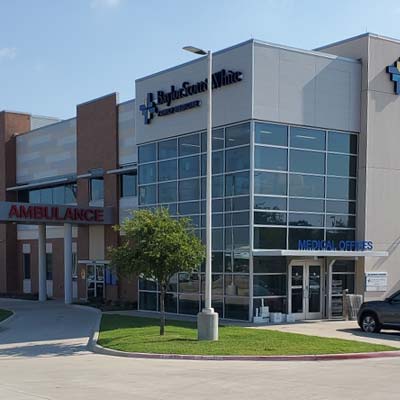At Baylor Scott & White Cottonwood Cardiology, the cardiovascular specialists here diagnose and treat disorders of the heart, which include congenital heart defects, coronary artery disease, heart failure, valvular heart disease and arrhythmia.
The physicians maintain privileges at several hospitals within the Irving/Grapevine community in an effort to better serve their patients.

Baylor Scott & White Cottonwood Cardiology - Grand Prairie
2740 N State Highway 360 Ste 100, Grand Prairie, TX, 75050- Monday: 8:00 am - 5:00 pm
- Tuesday: 8:00 am - 5:00 pm
- Wednesday: 8:00 am - 5:00 pm
- Thursday: 8:00 am - 5:00 pm
- Friday: 8:00 am - 5:00 pm

Baylor Scott & White Cottonwood Cardiology - Irving
1110 Cottonwood Ln Ste 105, Irving, TX, 75038- Monday: 8:00 am - 5:00 pm
- Tuesday: 8:00 am - 5:00 pm
- Wednesday: 8:00 am - 5:00 pm
- Thursday: 8:00 am - 5:00 pm
- Friday: 8:00 am - 5:00 pm

Baylor Scott & White Cottonwood Cardiology - Lake Ridge
3095 Kingswood Blvd Suite 250, Grand Prairie, TX, 75052- Monday: 8:00 am - 5:00 pm
- Tuesday: 8:00 am - 5:00 pm
- Wednesday: 8:00 am - 5:00 pm
- Thursday: 8:00 am - 5:00 pm
- Friday: 8:00 am - 5:00 pm

Baylor Scott & White Cottonwood Cardiology - Las Colinas
400 W IH 635 Ste 210, Irving, TX, 75063Hours of Operation
Hours of Operation
Office Hours
Insurances accepted
Baylor Scott & White has established agreements with several types of insurances in an effort to make sure your health needs are covered.
Medical services
Baylor Scott & White Cottonwood Cardiology offers cardiovascular expertise and heart treatment options conveniently located near you.
On-site services
- Exercise stress test
- Nuclear stress test
- Stress echocardiogram
- Echocardiogram
- Holter monitor/Event monitor
- Carotid artery sonogram
- Abdominal ultrasound
- Ankle brachial index
- Vascular studies
- Pacemaker/Defibrillator monitoring
Hospital procedures
- Coronary angiography
- Coronary intervention
- Peripheral angiography
- Peripheral intervention
- Transesophageal echocardiogram
- Percutaneous atrial septal defect closure
- Cardioversion
- Tilt table evaluation
- Catheter ablation
- Pacemaker insertion
- Defibrillator insertion
Conditions treated
- Arrhythmia
- Heart attack
- Congenital heart disease
- High blood pressure
- Diabetes
- Stroke
Pay bill
Baylor Scott & White Health is pleased to offer you multiple options to pay your bill. View our guide to understand your Baylor Scott & White billing statement.
We offer two online payment options:
- Make a one-time payment without registering by selecting the "Pay a Bill as a Guest" option.
- Enroll or login to your MyBSWHealth account to view account balances and statements, setup a payment plan or enroll in paperless statements.
Other payment options:
-
Pay by mail
To ensure that your payment is correctly applied to your account, detach the slip from your Baylor Scott & White billing statement and return the slip with your payment. If paying by check or money order, include your account number on the check or money order.
Please mail the payment to the address listed on your statement.
-
Pay by phone
Payments to HTPN can be made over the phone with our automated phone payment system 24 hours a day, seven days a week. All payments made via the automated phone payment system will post the next business day. Please call 1.866.377.1650.
If you need to speak to someone about a bill from a Baylor Scott & White Hospital, our Customer Service department is available to take payments over the phone from Monday through Friday from 8:00 AM - 5:00 PM and can be reached at 1.800.994.0371.
-
Pay in person
Payments can be made in person at the facility where you received services.
Financial assistance
At Baylor Scott & White Health, we want to be a resource for you and your family. Our team of customer service representatives and financial counselors are here to help you find financial solutions that can help cover your cost of care. We encourage you to speak to a team member before, during or after care is received.
Patient forms
To ensure that your visit to our office is as convenient and efficient as possible, we are pleased to offer our registration forms online. The patient registration form may be completed electronically and printed for better legibility or completed manually.
Other helpful information
Patient education: About your heart
Heart disease is the leading cause of death in the United States. Almost 2,000 Americans die of heart disease each day. That is one death every 44 seconds. The good news is that the death rate from heart disease has been steadily decreasing. Unfortunately, heart disease still causes sudden death and many people die before even reaching the hospital.
Your heart
The heart is a hollow, cone-shaped muscle located between the lungs and behind the sternum (breastbone). Two-thirds of the heart is located to the left of the midline of the body and 1/3 is to the right. The average weight of a female human heart is 9 ounces and a male’s heart is 10.5 ounces. The heart comprises less than 0.5 percent of the total body weight. The heart has three layers. The smooth, inside lining of the heart is called the endocardium. The middle layer of the heart muscle is called the myocardium. It is surrounded by a fluid-filled sac call the pericardium.
Chambers and valves
The heart is divided into four chambers:
- Right atrium (RA)
- Right ventricle (RV)
- Left atrium (LA)
- Left ventricle (LV)
Each chamber has a sort of one-way valve at its exit that prevents blood from flowing backwards. When each chamber contracts, the valve opens. When it is finished contracting, the valve closes so that blood does not flow backwards.
- The tricuspid valve is at the exit of the right atrium.
- The pulmonary valve is at the exit of the right ventricle.
- The mitral valve is at the exit of the left atrium.
- The aortic valve is at the exit of the left ventricle.
When the heart muscle contracts or beats (called systole), it pumps blood out of the heart. The heart contracts in two stages. In the first stage, the right and left atria contract at the same time, pumping blood to the right and left ventricles. Then the ventricles contract together to propel blood out of the heart. Then the heart muscle relaxes (called diastole) before the next heartbeat. This allows blood to fill up the heart again. The right and left sides of the heart have separate functions. The right side of the heart collects oxygen-poor blood from the body and pumps it to the lungs where it picks up oxygen and releases carbon dioxide. The left side of the heart then collects oxygen-rich blood from the lungs and pumps it to the body so that the cells throughout your body have the oxygen they need to function properly.
Patient education: Diet tips
Michael Rothkopf, MD, offers dietary tips for keeping your heart healthy.
Watch Dr. Rothkopf's video